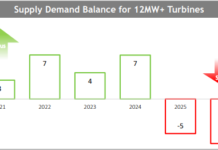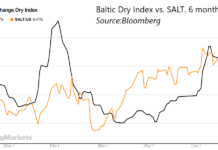Tom Konrad CFA
Offshore Wind in the United States
Last week, the long-embattled Cape Wind project got a break: Utility NStar(NST) agreed to buy 27.5% of the proposed offshore wind project’s output. Together with a previous power purchase agreement with National Grid (NGG), this gives Cape Wind a buyer for 77.5% of the project’s total projected output. Jim Gordon, Cape Wind’s President speaking at Offshore Wind Power USA in Boston, called the NStar deal the “starting gun” for Cape Wind’s financing round.
Yet speakers and attendees at Offshore Wind Power USA agreed that the Cape Wind story remains a cautionary tale for potential offshore wind developers, rather than a signal the the US offshore market is open for business. While the Bureau of Ocean Energy Management has made progress in defining the leasing process, this process is still expected to take six to eight years to complete. There remains a notable lack of coordination between and among the score federal and state agencies which have a say in the process.
Perhaps more importantly, the Production Tax Credit (PTC) and Investment Tax Credit (ITC) were not extended as part of the payroll tax cut extension. The American Wind Energy Association is continuing to pursue the PTC extension through other legislation, but many observers at the Offshore Wind conference opined that these incentives will not see any action until Congress’ lame duck session, after November election. Few offshore wind developers are willing to invest to move their projects forward until they have some certainty about the PTC and ITC, so most offshore wind projects in the United States are likely to remain on hold at least until the end of the year.
Europe
Offshore wind in the US is far from the whole story. The European Offshore Wind industry is entering its full commercial stage, with projects amounting to several gigawatts of capacity expected to be built over the next few years, making the global industry worthy of investors’ attention.
European offshore wind is not without hiccups. The European financial crisis has slowed (but not stopped) financing for wind farms, despite the fact that some farms require investments in the billion Euro range. Another recent problem, which will be familiar to onshore wind developers, is grid interconnection. Although Germany has a legal requirement that transmission operators connect new wind farms to the grid, this is an unfunded mandate, and the transmission companies do not have the funding or even enough of the right sort of cable to meet this obligation in a timely fashion. Grid connections for two large wind farms were recently delayed by 12 and 15 months because of such problems, costing the developers hundreds of millions of euros in electricity sales.
Offshore Wind as an Investment
Such hiccups happen in new industries, and they can lead to buying opportunities for investors. Often the best time to buy stock is after most people realize everything is not smooth sailing, but before all the problems are resolved. This allows excess returns, as stocks which were initially priced as highly risky investments gain value as the industry learns to tackle such challenges.
As the only renewable energy resource able to produce power on the scale of hundreds of gigawatts close to the world’s most energy-hungry and population dense cities in Europe and America’s Eastern seaboard, offshore wind will play a prominent role in the transition away from fossil fuels. The only question in my mind is when this transition will occur. My feeling is that this maturation of the offshore wind market (at least in Europe) will come within the next few years, leading to substantial rewards for investors with good timing.
Offshore Wind Stocks
Most onshore wind turbine manufacturers either already have turbines designed for offshore use, or are developing them. The current market leaders are Siemens (SI) and Vestas (VWDRY.PK), but Vestas is rapidly losing ground to a host of new entrants, including Chinese players like Sinovel (601558.SS) who are largely responsible for the fierce price competition which led to the poor performance of wind power stocks in 2011.
Given the inauspicious competitive environment among turbine manufacturers, I think better investments are to be found in other parts of the wind farm. According to Walt Musial, the manager of offshore wind and ocean power systems at the National Renewable Energy Laboratory, the turbines only account for 32% of the cost of a wind farm, on average. Fully 52% of the cost lies in other farm components, such as support structures, the undersea cables that collect power from the turbines and send it to shore, and the various power converters needed.
In short, many of the best offshore wind investments are the companies I call Strong Grid Stocks: the companies which help grid operators move electricity in bulk. I’d include among these cable manufacturers such as Prysmian (PRYMF.PK) and General Cable (BGC) (recall the German wind farms with grid connections delayed in part because of lack of cable, a sign of scarcity which leads to pricing power.) I’d also include the companies such as Siemens (SI), ABB Group (ABB), and Alstom (AOMFF.PK) who supply many aspects of the power conversion and interconnection hardware needed to tie wind farms to the grid. One of the reasons Siemens is expected to maintain its position as the world’s leading offshore turbine supplier for the next few years is the company’s ability to supply many of the parts and services offshore wind farms require in addition to the turbines. Alstom also seems to be following this strategy by introducing a broad range of new products (including a new 6MW direct drive turbine) for offshore wind.
Besides equipment manufacturers, offshore wind is likely to be a boon to shipbuilders with the capability of constructing the specialized ships needed to install large wind turbines and foundations, which are in short supply. Harbors near promising wind farms will also have to be improved to accommodate the large ships needed to install them, which is likely to help dredging companies such as Great Lakes Dredge and Dock (GLDD).
Conclusion
Offshore wind is destined to be a significant part of the energy seascape in the coming decades, and the industry is just getting its sea legs at the beginning of what will prove to be a long voyage. As of yet, I feel it it too early for most stock market investors to embark on this particular cruise, except perhaps on the sturdy platform of a large company with busine
sses in many other sectors, but which stands to benefit from the future growth of what promises to be a large and prominent renewable energy sector.
DISCLOSURE: Long GLDD.
DISCLAIMER: The information and trades provided here are for informational purposes only and are not a solicitation to buy or sell any of these securities. Investing involves substantial risk and you should evaluate your own risk levels before you make any investment. Past results are not an indication of future performance. Please take the time to read the full disclaimer here.







